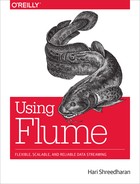0%
16Chapters
0-1Hours read
0kTotal Words
Book Description
How can you get your data from frontend servers to Hadoop in near real time? With this complete reference guide, you’ll learn Flume’s rich set of features for collecting, aggregating, and writing large amounts of streaming data to the Hadoop Distributed File System (HDFS), Apache HBase, SolrCloud, Elastic Search, and other systems.
Table of Contents
- Foreword
- Preface
- 1. Apache Hadoop and Apache HBase: An Introduction
- 2. Streaming Data Using Apache Flume
- The Need for Flume
- Is Flume a Good Fit?
- Inside a Flume Agent
- Configuring Flume Agents
- Getting Flume Agents to Talk to Each Other
- Complex Flows
- Replicating Data to Various Destinations
- Dynamic Routing
- Flume’s No Data Loss Guarantee, Channels, and Transactions
- Agent Failure and Data Loss
- The Importance of Batching
- What About Duplicates?
- Running a Flume Agent
- Summary
- References
- 3. Sources
- 4. Channels
- 5. Sinks
- 6. Interceptors, Channel Selectors, Sink Groups, and Sink Processors
- 7. Getting Data into Flume*
- 8. Planning, Deploying, and Monitoring Flume
- Index
